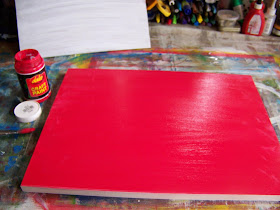I started today's project on an MDF board. I usually buy a whole board at a time and have it cut to size for me at the supplier for a modest addition to the price.
Add a little more to the price and they will edge the panels with the edging of your choice.
As this board will absorb a lot of paint, it is essential to seal it with a good primer. I use Universal Undercoat for this purpose.
Paint 2-3 coats of universal undercoat on the wood panel. Wait for the first coats to dry before applying successive coats.
Brushes used to apply universal undercoat has to be washed in lacquer thinner or turpentine. I suggest you wash the brushes in warm soapy water afterwards to prolong their lives.
Once the universal undercoat is dry, I paint the board with a coat of Dala Craft Paint in Red.
As soon as this layer is dry, I cover the whole board with crackle medium. I leave this to dry for 24 hours.
The next day, after the crackle medium has had a chance to dry properly, I apply a coat of Dala Craft Paint in Turquoise.
Although the cracks appear almost immediately, they will widen as the paint dries. The surface preparation is now complete and we can start painting pretty designs on the board.
I prepare a stay-wet palette for today's painting. This help to keep the paint fresh for longer, giving me the opportunity to finish the work before the paint dries on my palette. I have blogged about preparing a stay-wet palette before and you can read all about it here.
I will be using Dala Craft Paint for the project, but you could also try these techniques with acrylic paint, chalk paint, or blackboard paint.
Decide on the two colours you want to start with and put some on the palette.
Keep a paper towel handy, as you will need to wipe your brush to clear the secondary colour, before dipping into the primary colour again. This action will be repeated numerous times.
Find yourself a good round brush. A no 6 will probably be a good size. I aim to make rather large flowers and use a no 11.
Dip the brush in water to separate the bristles.
Dab on the paper towel to clear the excess water.
Dip into your primary colour, loading the brush almost up to the shaft.
Make sure the brush is loaded on all sides. Do not roll the brush in the paint, as this will cause the bristles to twist.
Dip the point of the brush into the secondary colour.
Lay the brush flat on the surface, pressing down, allowing the bristles to open up. Lift away without pulling the brush.
Clean the tip by wiping it. Dip in both colours and repeat until all the petals are painted.
One complete flower. In actual folk art, these strokes would be done much more meticulously, but that would not suit the rustic nature of my project. You need to decide for yourself how meticulous you need to be for your particular project.
I do groups of three flowers in each of the four corners.
I will now work on the foliage and select a primary and secondary colour for these.
I load the brush as before.
Dip into the secondary colour.
The brush strokes are exactly the same, but this time I work from the outside in, so that my secondary colour ends up on the ends of the leaves.
A completed cluster of leaves.
I will now be using a liner/rigger.
I opt for a vibrant colour to paint lines that will connect the different elements of my design.
Draw the lines steadily and not too fast, or the paint will not have time to run down the bristles of the rigger, leaving you with a half-drawn line.
Progress. I decide to add white highlights on the lines to lift them out from the dark background.
That is better!
I dip one half of the point of my round brush in the primary colour of the flowers.
I then dip the other side of the brush's point in the secondary colour.
The double-dipped point is merely touched to the surface of the board to give pretty little dots in two shades.
My design is now complete and I will use this board for another project. But first I have to make another board, much like this one, as a companion for the final project. Do not miss the next two blogs.
Marietjie Uys (Miekie) is a published author. You can buy the books here:
You can purchase Designs By Miekie 1 here.
Jy kan Kom Ons Teken en Verf Tuinstories hier koop.You can purchase Designs By Miekie 1 here.
Jy kan Kom Ons Kleur Tuinstories In hier koop.
Jy kan Tuinstories hier koop.
For more crafty ideas and great products, visit A Pretty Talent on Facebook.
Remember to keep nurturing your TALENT for making PRETTY things.
You can subscribe to this blog and receive regular updates by email by simply registering your email address at the top of the current blog.






































No comments:
Post a Comment